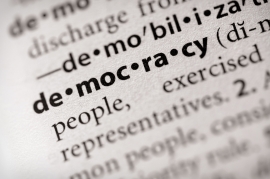Reforming California's broken proposition system

The California ballot proposition system, instituted in 1911, was meant to be a form of direct democracy where ordinary voters could bypass the legislature and go directly to the voters via an initiative. What we have now is far from that.
Big money and well-funded special interests force propositions on the ballot, and propositions are sometimes quite deliberately worded to do the opposite of what they imply. This is not democracy in action and worse, there could be dozens of them on the ballot in November. Our current proposition system is broken, easily gamed, and too often does the opposite of what it was intended to do. It needs to be changed.
The California primary election on June 8 has five propositions on it (which some might say is already too many.) But in the pipeline, seven are awaiting final verification and - brace yourselves - at least fifty six are in the process of getting signatures. Thus, it is quite possible there will be twenty or more propositions on the November ballot.
Topics include legalizing marijuana for personal use, making budget votes pass on a majority not two-thirds, suspension of air pollution laws, making flood insurance not mandatory, barring anyone but the Attorney General from challenging an Environmental Impact Report by lawsuit, and redrawing congressional districts.
But wait, there’s more.
Several propose taxes of various types and there are campaign contribution restrictions, plus more than a few are so opaque I’ve no idea what they would do. And finally there is one proposition that, no joke, if it passes “rewrites the entire state constitution.” Well gosh, I’ve got a spare month to sit down and read all of them.
How about you?
The initiative process requires getting signatures from registered voters amounting to 5% of voters in the most recent election for governor. The signature gathering is a problematic area. Large, well-funded groups simply pay canvassers to collect signatures. So, that friendly person collecting signatures outside the grocery store may have no particular interest in the issue, it’s just a way to get money, and they can be paid upwards of $8 a signature. But when signatures are paid for, the whole idea of direct democracy starts to get lost.
This is especially true when a proposition is essentially funded by a corporation with a direct financial interest in the outcome. Proposition 17, which is on the June ballot, is funded almost entirely by Mercury Insurance Company. They paid a signature collecting company $2.2 million to get the signatures and have put in almost $10 million, 98% of the total funding.
This leads to another reason why the proposition system is broken. Prop 17 implies it will allow insurance companies to give “persistency discounts” to new customers. But is that really true? Many opponents say No and - call me cynical - but I just can’t see an insurance company spending $10 million so they can save you money. Can you? I’ve read the proposition several times and still have no clear idea what it will do. Many propositions are equally murky in meaning, and sometimes quite deliberately so.
As recently mentioned, the California Jobs Initiative will probably be on the November ballot. It seeks to overturn the landmark California Global warming law and is both misleadingly named and funded primarily by two out-of-state oil companies, Valero and Tesoro. Where is the direct democracy in this?
Then there’s the dueling propositions problem. One proposition seeks to overturn another proposition, or two conflicting propositions are on the ballot at the same time. What happens if both of them pass?
Clearly, the current system is unworkable and probably causes more problems than it solves. If we want to get back to real direct democracy, then the system needs a major overhaul. Therefore, I propose:
• No out-of-state contributions. This includes people and corporations. Nor can they funnel money to PACs in California who then give to the campaign. The original source of all contributions must be from inside California.
• Corporations not headquartered in California cannot donate money to a proposition campaign.
• Strict limits on the amount of money that any entity can donate, maybe $10,000 for people and $25,000 for a corporation, non-profit, or PAC.
• Propositions must be clearly written and understandable by a high school graduate. They cannot imply one thing but actually do another. The basic idea should be clearly explainable in no more than a short paragraph.
• Funding, costs, and hidden costs of a proposition must be accounted for. Unfunded mandates from propositions are a major contributing reason for the current budget crisis. It needs to stop.
• Lower the percentage of signatures needed to 2%. Ban paying people paid to collect them. Direct democracy means you care enough about it to get in the streets and do it yourself without pay.
Few states have a proposition system like California. What was intended as a way for voters to directly change the system is now abused, gamed, and clearly becoming unworkable – as the tsunami of mostly corporate-backed propositions that will be on the November ballot clearly indicates.
We need a change.





